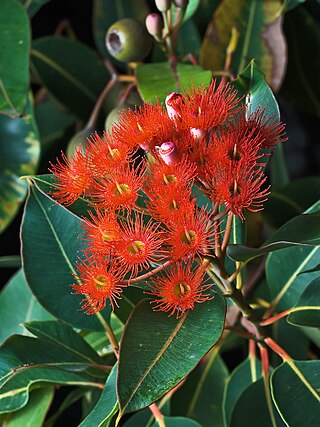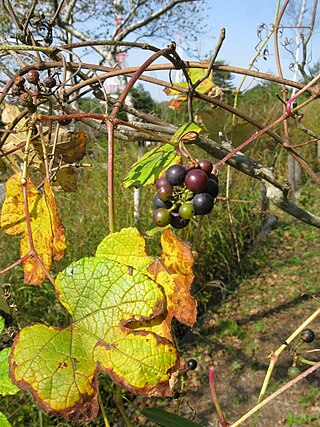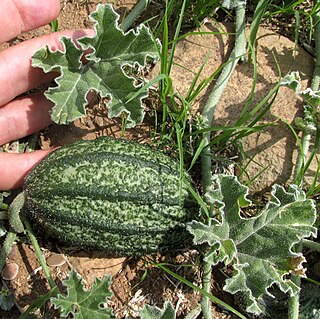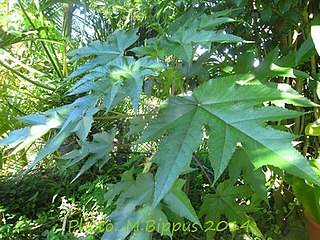
Mistletoe is the common name for obligate hemiparasitic plants in the order Santalales. They are attached to their host tree or shrub by a structure called the haustorium, through which they extract water and nutrients from the host plant. There are hundreds of species which mostly live in tropical regions.

Cucurbita is a genus of herbaceous fruits in the gourd family, Cucurbitaceae, native to the Andes and Mesoamerica. Five edible species are grown and consumed for their flesh and seeds. They are variously known as squash, pumpkin, or gourd, depending on species, variety, and local parlance. Other kinds of gourd, also called bottle-gourds, are native to Africa and belong to the genus Lagenaria, which is in the same family and subfamily as Cucurbita, but in a different tribe, their young fruits are eaten much like those of the Cucurbita species.

A lignotuber is a woody swelling of the root crown possessed by some plants as a protection against destruction of the plant stem, such as by fire. Other woody plants may develop basal burls as a similar survival strategy, often as a response to coppicing or other environmental stressors. However, lignotubers are specifically part of the normal course of development of the plants that possess them, and often develop early on in growth. The crown contains buds from which new stems may sprout, as well as stores of starch that can support a period of growth in the absence of photosynthesis. The term "lignotuber" was coined in 1924 by Australian botanist Leslie R. Kerr.

Corymbia ficifolia, commonly known as red flowering gum, is a species of small tree that is endemic to the south-west of Western Australia. It has rough, fibrous bark on the trunk and branches, egg-shaped to broadly lance-shape adult leaves, flower buds in groups of seven, bright red, pink or orange flowers and urn-shaped fruit. It has a restricted distribution in the wild but is one of the most commonly planted ornamental eucalypts.

Tiliaceae is a family of flowering plants. It is not a part of the APG, APG II and APG III classifications, being sunk in Malvaceae mostly as the subfamilies Tilioideae, Brownlowioideae and Grewioideae, but has an extensive historical record of use.

Cucurbita ficifolia is a species of squash, grown for its edible seeds, fruit, and greens. It has common names including black seed squash, chilacayote, cidra, fig-leaf gourd, and Malabar gourd. Compared to other domesticated species in its genus, investigators have noted that samples of C. ficifolia from throughout its range are relatively similar to one other in morphology and genetic composition. Variations do occur in fruit and seed color, some isozymes, and photoperiod sensitivity.

Kings Park is a 399.9-hectare (988-acre) park overlooking Perth Water and the central business district of Perth, Western Australia.

Alcea rosea, the common hollyhock, is an ornamental dicot flowering plant in the family Malvaceae. It was imported into Europe from southwestern China during, or possibly before, the 15th century. William Turner, a herbalist of the time, gave it the name "holyoke" from which the English name derives.

Brassaiopsis is a genus of shrubs in the family Araliaceae. There are about 45 species, distributed in Asia from the Himalaya through China, Vietnam, Thailand to Indonesia.

Ochrosia is a genus of flowering plants, first described in 1789. It is in the family Apocynaceae, native to Southeast Asia, Australia, and various islands of the Indian and Pacific Oceans.

Vitis ficifolia is a species of liana in the grape family native to the Asian temperate climate zone. It is found in mainland China, Japan, Taiwan and the Koreas.
Vitis heyneana is a species of climbing vine in the grape family endemic to Asia. It can be found in shrubby or forested areas, from almost sea-level, to 3200 meters above. It has globose berries that are purple to almost black.
Cucurbita lundelliana is a mesophyte plant species of the genus Cucurbita. It is native to Mexico, Guatemala, and Belize. It has not been domesticated. It is found in the Yucatán region near sea level among limestone cliffs. In Guatemala it is found in Parque Nacional Yaxha Nakum Naranjo along Rio Ixtinto and near Laguna Julequito.

Cucurbita pedatifolia is a xerophyte plant species of the genus Cucurbita. It is native to Querétaro, Mexico. It has not been domesticated. While C. pedatifolia has been cross bred, results have met with limited success. It does not cross well with other species of Cucurbita. It is a close relative of Cucurbita radicans. Geographic location and genetics make it highly likely that Cucurbita scabridifolia is a naturally occurring hybrid of Cucurbita foetidissima and C. pedatifolia. It also has some mesophyte traits may represent a transitional state between the mesophytic Cucurbita and the xerophytic Cucurbita.

Obetia is a genus of dioecious plants in the family Urticaceae, with stinging hairs. The genus contains the following species:

Eucalypteae is a large tribe of flowering plants in the family Myrtaceae; members of this tribe are known as eucalypts. In Australia the genera Angophora, Corymbia, and Eucalyptus are commonly known as gum trees, for the sticky substance that exudes from the trunk of some species. As of 2020, the tribe comprised around 860 species, all native to Southeast Asia and Oceania, with a main diversity center in Australia.
Aporosa ficifolia is a species of shrub in the family Phyllanthaceae. It grows 2-8m tall, it has a restricted habitat, growing in lowland open or pine forests up to 700m elevation.

Clappertonia is a genus of flowering plants belonging to the family Malvaceae.

Decaschistia is a genus of flowering plants belonging to the family Malvaceae.
Alcea ficifolia, commonly known as the fig leaf hollyhock, fig hollyhock and Antwerp hollyhock, is a perennial herbaceous plant in the mallow family (Malvaceae). This species is native to Iran and introduced into Europe, and it is well-known for its beautiful, tall flower spikes.
















